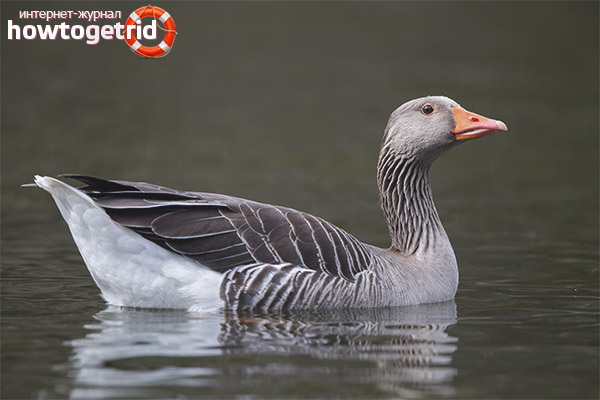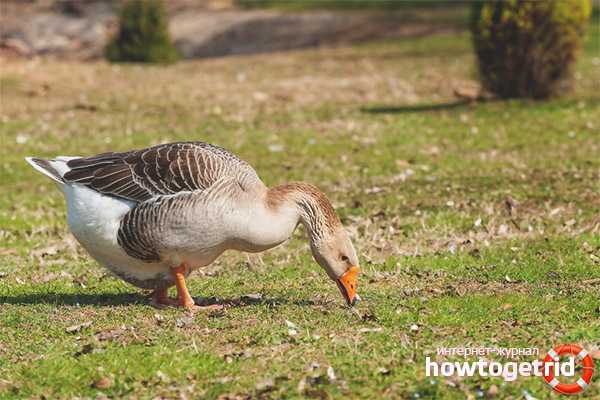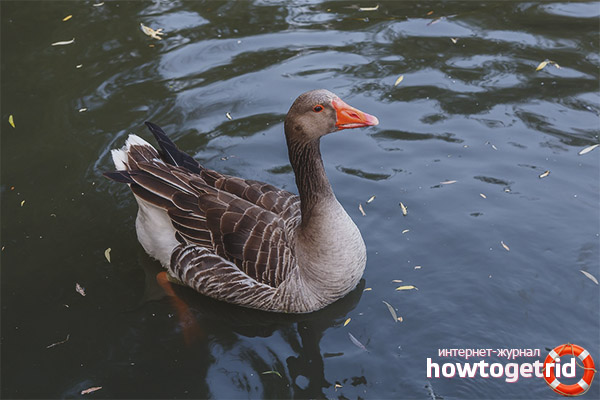The content of the article
The owners keep gray geese in the home yard because they give them meat, fluff, eggs, and fat. If the village farm does not have a reservoir, then this is not an obstacle to the maintenance of this type of geese. Unlike the gray wild goose, this homely species is perfectly dispensed with water.
Main characteristics
Wild geese, which are the ancestors of the domestic species, began to tame about 3 thousand years ago. This could be observed in the powerful Roman Empire, mysterious and unique Egypt, and other states. Birds were crossed with various other species and fertile hybrids were obtained. It can be assumed that the gray, white Chinese and black Canadian goose are associated with the same ancestor, which is Anser anser.
Domestic descendants are characterized by the preservation of the main features that the gray wild goose has. The bird is distinguished by power, endurance, strength. The wingspan can reach 180 cm. The gray color of the feathers is noted, which birds in the wild use for masking. With this color, the bird will be invisible among the reeds and when in the grass. However, from the sides and from below, the body is white in color. The scale of the wings became blurry.
Large body sizes with a wide muscular chest did not change. The head is large in size with the presence of a beak, which has a red-orange color. Strong wings emphasize the splendor of this bird in flight. The neck is slightly elongated. Legs are stronger and taller than wild representatives. The claws on the legs perform a protective function, and the presence of membranes ensures the bird is comfortable in the water. The wide setting of the legs is no coincidence. This allows you to quite firmly hold a fairly massive fat body.
Domestic geese are highly mobile. They are characterized by endurance and unpretentiousness to food. The weight of an adult goose can reach almost 8 kg. If concentrated feed is used in goose nutrition, then the bird can gain all 10 kg. The body weight of wild relatives is almost 3 times less than the domestic representatives.
What is the purpose of breeding geese?
The meat color is dark and in many respects resembles chicken legs, however, it has a more pronounced stiffness. Geese are able to travel long distances. Hence the tough nature of the meat. There is a lot of fat in goose meat, the value of which reaches almost 50%. The goose liver is very valuable in birds. By weight, it is 350-450 g.
A good layer of fat serves the bird for reliable thermal insulation. Goose fat benefits far more than chicken. Fat for the goose acts as an energy source. Most of it contains the skin, where almost all the glands are concentrated, in which the lubricant necessary for the bird to swim is produced. This grease soaks the plumage of a goose. The calorie content of meat is determined by the presence or absence of the skin and reaches 400 kcal in terms of 100 g of the product, if any.
Goose fat is rich in polyunsaturated fatty acids. They are important for the immune system of birds. It is used in the manufacture of certain medications, as well as for cosmetic purposes.
Geese carry eggs. When a bird turns three months old, it can bring up to 50 eggs. Goose eggs are characterized by high biological value. They are highly nutritious and high in calories. The composition contains a rich vitamin and mineral set. Eating goose eggs improves cerebral circulation. The high yolk content of lutein provides good antioxidant properties of goose eggs.
Unlike chickens, geese fluff also has great advantages. It is used as a heater for clothing. It is also used in the manufacture of bedding. Things that use goose down last a quarter of a century. Collection is carried out three times a year. One bird can give up to 4 kg of fluff throughout life.
Creating habitat
In terms of quality and quantity of their products, geese are significantly ahead of other representatives of the bird kingdom. Many people prefer to breed this species in their household. Large gray geese have several distinct advantages. These include:
- The bird can freely graze without assistance.
- Gray geese can be bred in the absence of a reservoir.
- The content is not associated with any special requirements.
- The bird is quite resistant to various diseases.
- Reproduction is notable for decent performance.
- Offspring are growing at an accelerated pace.
- The gray goose is strongly attached to the person.
In food, the bird is characterized by pronounced unpretentiousness. During the day, she is able to eat about 2 kg of fresh grass. Nevertheless, the introduction of cereals, alfalfa, bran, oilcake into the diet is required. Carrots, leeks, celery, and lettuce are also added. It is recommended to add chalk. Make reserves for the winter in the form of branches of birch, aspen, alder. In winter, their leaves are added to the feed. Some use dried algae powder.
If the corral method is used for keeping, then the geese themselves cannot graze. This will certainly entail additional costs for their maintenance. But for fattening, this method is more profitable. In this case, a balanced calorie feed is used in the diet. Basically, this method is used in industrial production.
On the farm, free grazing is more beneficial. It is only necessary to choose the appropriate place for grazing. The plot should contain swamps. Ponds with clean water are required. You can organize a pond at your farmstead. But it is necessary to ensure that geese enter and exit freely. You can use small containers in which water is poured. The water tank must be cleaned regularly and the water changed.
You can keep geese in a small barn or in some other room. You can use the aviary. But with this content, it is necessary to provide reliable protection against predatory representatives.
Geese have good resistance to environmental changes. Despite this, the canopy in the summer heat they clearly will not hurt. When kept in sufficient quantities, troughs and drinkers are arranged. They are placed evenly and periodically subjected to purification.
The goose has quite good health. However, preventive measures aimed at preventing infections will never hurt. For this purpose, the location for the geese is kept clean. The most susceptible birds to a steam virus infection. Fatal outcomes with the disease are rare, although they are quite possible.
Geese should not be kept on bare ground. The floor for them is covered with sawdust or straw is used for this. Litter should be present in sufficient quantities. Recommended daily litter change. This is to prevent mold from developing and developing.
It is recommended to dry the barn and treat its structures with a solution of superphosphate.It is prepared at the rate of 200 g per square meter. After processing, the barn is ventilated and dried.
Ideal qualities of parents
The gray goose boasts not only high health indicators, but also a high ability to reproduce. If birds create ideal conditions for growth and development, then a goose at the age of 9 months can reach a weight of 6 kg. In the first year of keeping, the female will give 25 eggs, each of which weighs more than 200 g. In the future, she will bring 4-6 dozen eggs.
The female always acts as an excellent brood, showing excellent parental qualities. In the presence of favorable conditions, the female is able to bring up to 15 full goslings. For their growth, appropriate conditions are created. What does it mean? Offspring are provided with the necessary nutrition. Sour milk, cottage cheese, and reverse are introduced into the diet. Adequate availability of drinking is provided.
The laying hen should be isolated from other geese. This will prevent potential brawls. For geese, existence in pairs is characteristic. The male is also in good condition, as the female performs the role of protector of the offspring.
In order for the female to lay eggs properly, favorable conditions are created. Daylight hours at the place of detention should last at least 12-14 hours. The temperature should be maintained at 14 degrees. The female lays eggs once every two days. Their shelf life is not more than 10 days.
Large bird sizes suggest a low birth rate. The eggs are large, but there are fewer than those of other species. A certain imprint is also imposed by the fact that the goose belongs to the monogamy. The development of females is ahead of males. They are clearly not yet capable of fertilization. Birds aged 3-4 years have maximum fecundity. Then this ability tends to decrease.
When offspring appear, feeders are arranged for him. Their size is determined by the age of the goose. During the first two months of life, the bird grows rapidly. In order for the goose to gain at least 1 kg of weight, it will need crushed grain in the amount of 2.5 kg and moistened feed in the amount of 9 kg.
The gray goose is the pride of breeders and breeders. Despite the fact that the existence of the founders of the breed dates back to ancient times, a large gray goose appeared only in the last century. To create the breed, Toulouse gander and Romance geese were selected. After that, there was already an internal selection associated with the obtained hybrid species.
Selection work is ongoing today. The gray goose has all the features that allow it to be crossed with representatives of other breeds. Efforts are not in vain. Currently, a number of hybrids with a high ability to carry eggs have been obtained. This ability does not decrease for five years of their life. The meat of such birds has the best taste. Received such hybrids that do not show a pronounced demand on their content. They expressed the properties of resistance to various adverse environmental factors.
Video: gray goose (Anser anser)












Submit